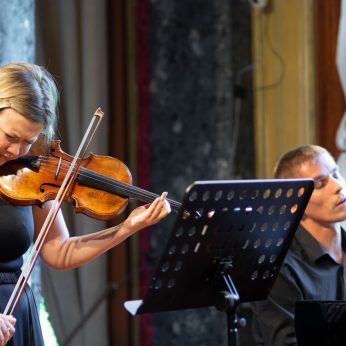Composer: Robert Schumann (b. 1810 - d. 1856)
Performance date: 25/06/2023
Venue: Bantry House
Composition Year: 1853
Duration: 00:20:02
Recording Engineer: Tom Norton
Instrumentation: vn, pf
Instrumentation Category:Duo
Artists:
Alina Ibragimova -
[violin]
Cédric Tiberghien -
[piano]

Violin Sonata No.3 in A minor WoO 2 – Frei aber einsam [1853]
1. Ziemlich langsam
2. Lebhaft
3. Intermezzo – Bewegt doch nicht zu schnell
4. Finale – Markiertes ziemlich lebhaftes Tempo
Visit from Brahms (a genius).
Robert Schumann diary entry. 1 October 1853.
On the last day of September in 1853 a nervous 20-year-old Brahms called on the Schumann household in Düsseldorf and was told by their daughter, Marie, to call back the next day. When he returned, he was asked to play for them and the famous Schumann couple were mesmerised by his playing of his early sonatas. Just a year earlier Brahms’ music and personality had had a similar effect on the already famous violinist, Josef Joachim, who was barely two years older than Brahms but a decade older in experience. It was Joachim who insisted Brahms should call on the Schumanns.
Over that month the Schumanns feted both Brahms and Joachim and Robert took the vital step of recommending his new young friend to the publisher Breitkopf and Härtel, while also introducing him to the composer Albert Dietrich. That same month Schumann came up with the idea of the FAE Sonata whereby he, Brahms and Dietrich would each write movements of a Sonata to present to Joachim on his next visit, the music to focus on Joachim’s motto Frei Aber Einsam (free but solitary). Schumann himself wrote the second and the last movements, Brahms the Scherzo and Dietrich the opening. From out of this friendly enterprise, Schumann created his Third Sonata writing his own first and third movements over three days at the end of that busy month with a first performance 2 weeks later.
In my note on Event 19, Schumann Geister Variations, I tell the story of Schumann’s last months in Düsseldorf where he was driven to raging madness by the voices in his head, a time of extreme distress for Clara. Strangely when Schumann was finally taken to the sanatorium, she got great consolation from playing this final Sonata with Joachim, but later she refused to publish it as she felt it was tainted by his madness. Today both musicians and audiences are intrigued by this message from the edge.
The jagged slow introduction gives a foretaste of Schumann’s state of mind, savage chords, edgy cries by the violin, wild runs by the piano seem a prelude to a storm, which never quite materializes. The music seems at times close to disintegration, partially redeemed by glimpses of melody soon lost again. The sudden mood changes are particularly demanding for the violinist who carries the weight of these messages from the other side. The Scherzo, usually but not always played second, has an even more jagged opening, but relents into something almost gentle, as if Clara or one of the children came into the room. The two characters alternate until the opening roller-coaster returns to close the movement.
At last the Intermezzo reminds us how beautiful his music could be, garlands of gentleness over Joachim’s FAE motto. But it is too short a time before we are thrown back into the earlier maelstrom over dragged out chords and occasional scraps of melody. As we approach the end the music makes a great effort to overcome the threatened disintegration and closes triumphantly.
Francis Humphrys
Copyright © 2025 West Cork Music. All rights reserved.
Designed and developed by Matrix Internet